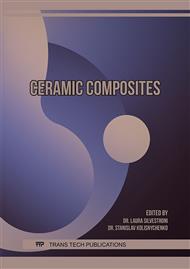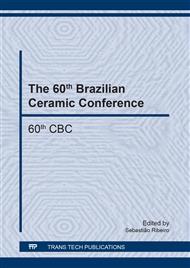[1]
C.C. Gonzaga, Crescimento de trincas subcrítico em cerâmicas odontológicas: efeito do material (microestrutura) e do método de ensaio. Doutorado (Tese). São Paulo, 2007. Universidade de São Paulo (USP/ODONTO). (SP).
DOI: 10.11606/t.23.2007.tde-03012008-110223
Google Scholar
[2]
G.A. Borges, A.M. Spohr, M.F. Goes, L.C. Sobrinho, D.C.N. Chan: J Prosthet. Dent. Vol. 89 (2003), p.479.
Google Scholar
[3]
R. Brum, R. Mazur, J. Almeida, G. Borges, D. Caldas: Oper Dent. Vol. 36 (5) (2011), p.478.
Google Scholar
[4]
G. Sannino, F.L. Arcuri, E. Bigelli, C. Arcuri, A. Barlattani: Oral & Implantology Vol. 3 (2014), p.57.
Google Scholar
[5]
R.M. Melo et al.: J. Esthet. Restor. Dent. Vol. 22 (4) (2010), p.262. Vol.
Google Scholar
[6]
M.F. Haddad, E.P. Rocha, W.G. Assunção: J. Craniofac. Surg. Vol. 22 (2011), p.952.
Google Scholar
[7]
C.L. Melo-Silva, C.F. Carvalho, C. Santos, J.F.C. Lins: Materials Science Forum Vol. 727-728 (2012), p.826.
Google Scholar
[8]
C.L. Melo-Silva, T.C.F. Melo-Silva, C.F. Carvalho, J.P.S. Sudré, R.X. Freitas, J.P. Gouvêa, J.F.C. Lins: Materials Science Forum Vols. 820 (2015), p.315.
DOI: 10.4028/www.scientific.net/msf.820.315
Google Scholar
[9]
V. Jardel, M. Degrange, B. Picard, G. Derrien: Int. J. Prosthodont. Vol. 12 (5) (1999), p.415.
Google Scholar
[10]
G.W. Ho, J.P. Matinlinna: J. Adhes. Sci. Technol Vol 25 (2011), p.2671.
Google Scholar
[11]
M. Meldrum: Regul Toxicol Pharmacol. Vol. 30. (1) (1999), p.110.
Google Scholar
[12]
M. Ozcan, A. Allahbeickaraghi, M. Dündar: Clin. Oral Investing. Vol. 16 (1) (2012), p.15.
Google Scholar
[13]
O. Addison, P.M. Marquis, G.J.P. Fleming: Dent. Mat. Vol. 23 (2007), p.461.
Google Scholar
[14]
S. Kruger, J. Deubener, C. Ritzberger, W. Holand: Int. J. Appl. Glass. Sci. Vol. 4 (2013), p.9.
Google Scholar
[15]
A.M. Filho, L.C. Vieira, E. Araújo, S. Monteiro Júnior: J Prosthodont. Vol. 13 (1) (2004), p.28.
Google Scholar
[16]
A. Fabianelli, S. Pollington, F. Papacchini, C. Goracci, A. Cantoro, M. Ferrari, R. Van Noort: J. Dent. Vol. 38 (1) (2010), p.39.
DOI: 10.1016/j.jdent.2009.08.010
Google Scholar
[17]
A.P. Manso, N.R. Silva, E.A. Bonfante, T.A. Pegoraro, R.A. Dias, R.M. Carvalho: Dent. Clin. North. Am. Vol. (55) (2) (2011), p.311.
Google Scholar
[18]
M.T. Yucel, F. Aykent, S. Akman, I. Yondem: Journal of Non-Crystalline Solids Vol. 358 (2012), p.925.
DOI: 10.1016/j.jnoncrysol.2012.01.006
Google Scholar
[19]
PC. Guess, S. Schultheis, E.A. Bonfante, P.G. Coelho, J.L. Ferencz, N.R. Silva: Dent. Clin. North Am. Vol. 55 (2) (2011), p.333.
Google Scholar
[20]
L.M. Martins, F.C. Lorenzoni, B.C. Farias, L.D. Lopes, G. Bonfante, J.H. Rubo: Cerâmica (2010).
Google Scholar
[21]
D.J. Fasbinder, J.B. Dennison, D. Heys, G. Neiva: J. Am. Dent. Assoc. Vol. 2 (2010), p. 10s-14s.
Google Scholar



